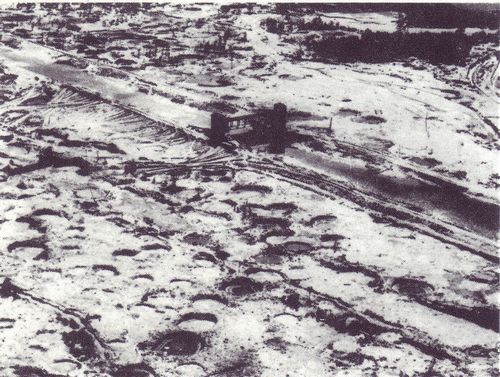The 1944-45 Raids at Ladbergen
The 1944-45 Raids at Ladbergen The first attack on the Ladbergen aqueducts took place during the evening of the 23rd September 1944 with 136 Lancasters and 5 Mosquitoes from 5 Group.
Descriptions of the raid vary from the surprisingly matter of fact:
"An uneventful trip".........to the rather more vitriolic................"No control whatsoever."
A Pathfinder crew declared:
"In no way could the raid be described as a success......It is hoped however, that some damage was done to the enemy."
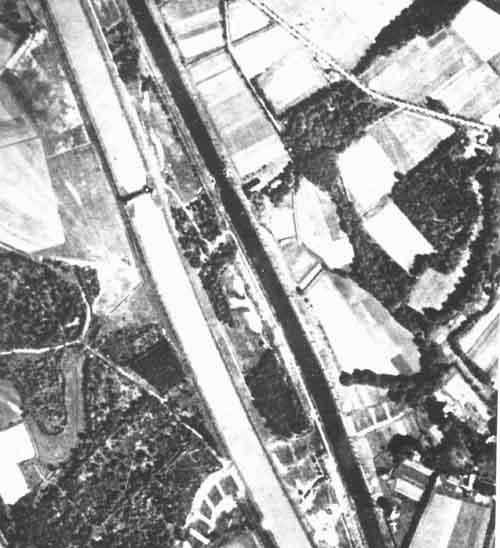
The target area at Ladbergen with the two channels and camouflage protection clearly visible.
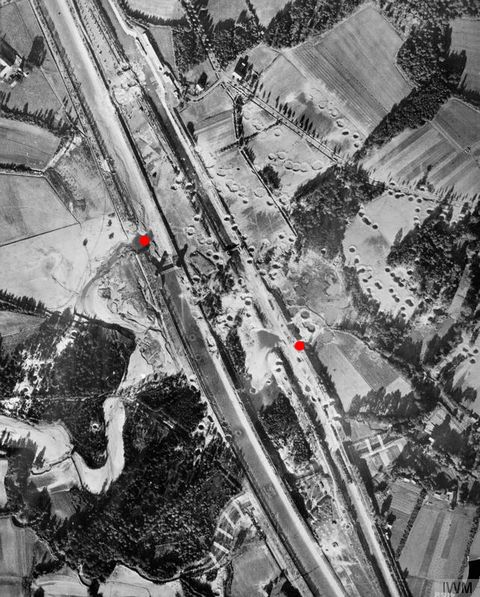
Problems with accurately marking the target and faulty radio equipment made the raid somewhat chaotic.
It was therefore a welcome surprise to see that the raid had been a success. Although the aqueducts had not been destroyed, Tallboy hits had breached the banks of both branches (shown by the red dots).
The price however, was once again high with over 10% of the force (14 Lancasters) being lost.
The majority of losses were to flak and Luftwaffe nightfighters whilst over Holland.
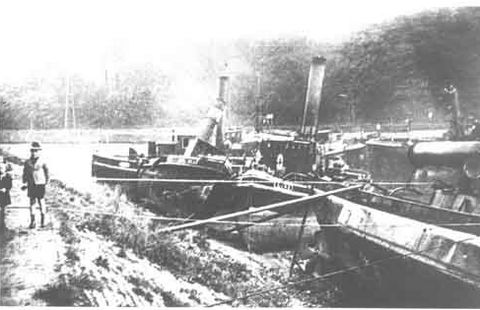
The scene on the 24th September at Bevergen. Over eighteen miles of the Dortmund Ems canal had been drained between Münster and the junction with the Mittelland Canal at Bevergen stranding over 100 barges.
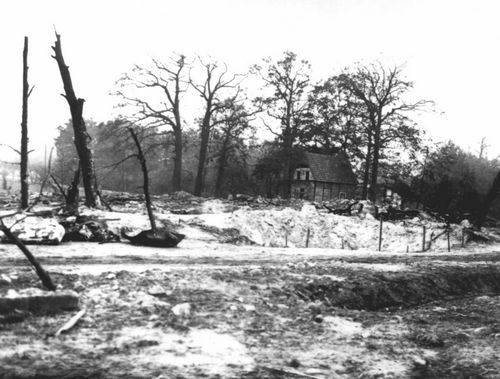
The Ladbergen town records state that at the beginning of the raid (10:30pm) a bomber loaded with bombs crashed on the Schulte farm and exploded. Recent information describes how two Lancasters (both with inexperienced crews) collided over the target. One of the Lancasters went "straight in" and the other crashed a few miles away near Ibbenbüren.
The two Lancasters in question were LM223 and LM309.
LM223 was from 463 squadron out of Waddington, piloted by F/O Sydney John Staples and were on their first operation.
LM309 also from 463 squadron was piloted by F/O FJ 'Jack' Lindquist and were flying their second operation.
F/O Lindquist and Flight Sergeants Howard and Sloane of LM309 managed to bail out and became PoWs; the rest of the crew did not survive.
It seems very likely therefore that the Lancaster which caused such devastation was LM223.
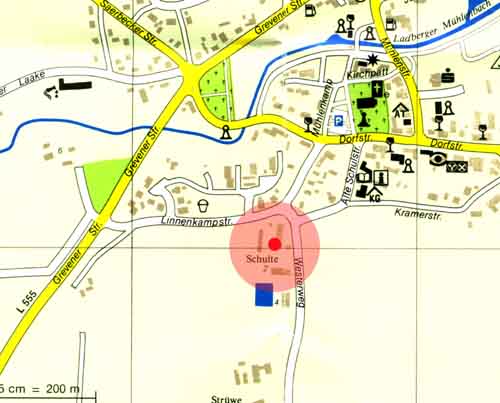
The location of the Schulte farm and the crashsite.
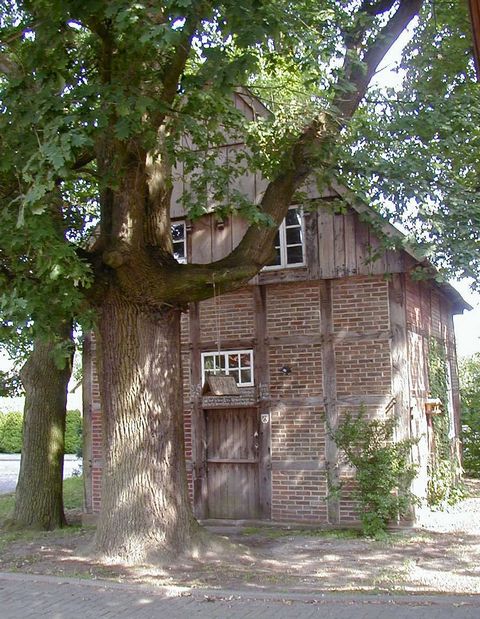
Although the main farm buildings were destroyed, this small out-house survived and can be seen today next to the new farmhouse. You can see this building to the right of centre in the wartime black and white image above.
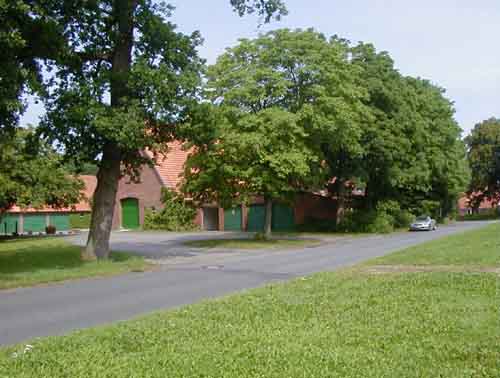
This photograph is taken from the same location as the WW2 image. The small out-house is behind the new farm building and is completely invisible in this comparison shot. It should be remembered that the original farm house was completely destroyed by the crashing bomber thus making the out-house visible.
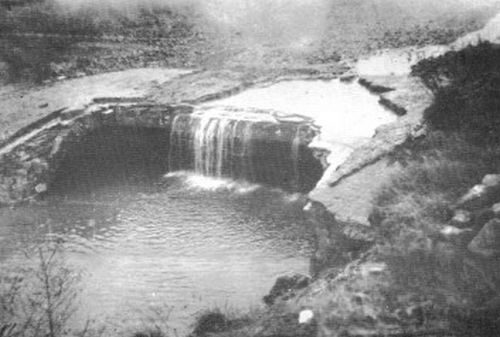
The damage to the canal from the first attack had hardly been patched up when, at around 7pm on the evening of November 4th, the second attack came. This time the aqueduct was badly damaged and the canal bank was breached for about 20m. The water ran out of the canal and, once again, all canal traffic was brought to a halt.
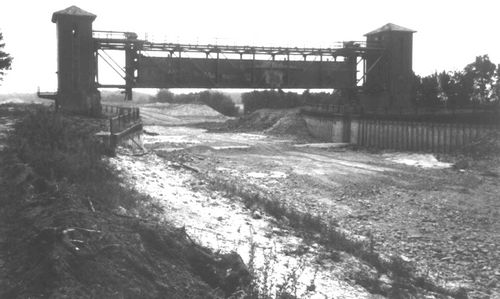
After the damage caused by the second raid had been repaired, but before canal traffic could resume, the third raid struck. The canal was heavily damaged and the water gushed into the valley and transformed the fields into a lake of water.
The photograph shows a canal safety gate shown in the open position.
Following this attack, huge efforts were made to repair the canal by almost 4000 Todt Organisation labourers. They were mostly accommodated in Ladbergen which had taken on the appearance of a huge labour camp. Before their work was completed however, the fourth attack came at 11am on New Year's Day. 102 Lancasters and 2 Mosquitoes from 5 Group bombed the canal from a cloudless blue sky. The area was extensively damaged and delayed actions bombs were exploding well into the next day. Five Lancasters were lost ....although two of these were aircraft crashing almost immediately after take off.
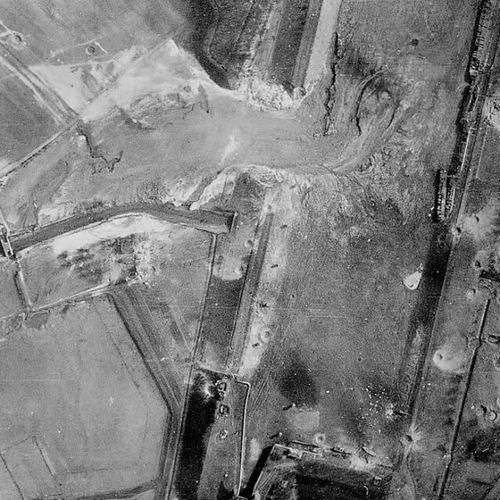
Towards the top of the picture is the breach where the water has drained out of the canal into the neighbouring fields.
One of the losses was a 9Sqn Lancaster piloted by F/O Denton. Shortly after bombing he was hit by flak and set on fire. F/Sgt George Thompson, the wireless operator, rescued both gunners from their burning turrets but suffered severe burns in doing so. The Lancaster crash landed at Brussels and Thompson was rushed to hospital where he died three weeks later. The mid-upper gunner, Sgt Potts also died. F/Sgt Thompson was awarded a posthumous Victoria Cross for his courage.

The citation reads:
Flight Sergeant Thompson was the wireless operator of a Lancaster which attacked the Dortmund-Ems Canal on 1 January 1945. The aircraft had twice been hit by anti-aircraft shells; the first hit the mid-upper turret and set the aircraft on fire, filling it with dense smoke; the second shell struck the nose of the aircraft which caused an inrush of air, clearing away the smoke but revealing a scene of utter devastation Flight Sergeant Thompson immediately saw that the mid-upper gunner was trapped. Without a moment's hesitation he entered the blazing turret and pulled the unconscious gunner free. He carried him to safety and then with his bare hands extinguished the gunner's blazing clothing, sustaining serious burns in the process. Flight Sergeant Thompson then noticed that the rear gun turret was also on fire, and despite his injuries, made his way to the rear of the aircraft; once again ignoring his own safety, he entered the burning turret to rescue the unconscious rear gunner, and with his already badly burnt hands, extinguished the gunner's blazing clothing. Even though he was now almost completely exhausted, he made his way forward to the captain to report on the fate of the crew. So pitiful was his appearance that his captain failed to recognise him. Even so, Thompson's only concern was for his 2 comrades left in the rear of the aircraft.
The fifth attack at midnight on the 7th February 1945 was not a success and the reinforced air defences around Ladbergen prevented the attack being concentrated. As a result the Lancaster force of 177 were scattered and many of their delayed action bombs fell into open fields and the canal was mostly undamaged. Five Lancasters were lost in this action.
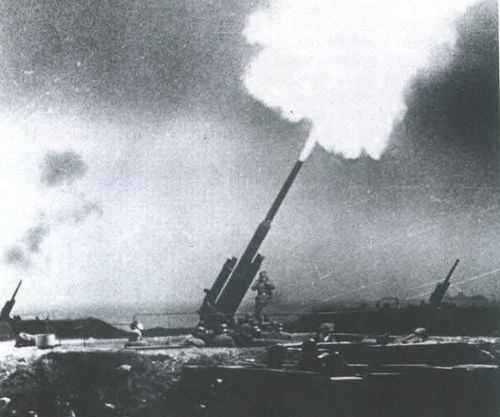
The final large raid was on March 3rd at 9:40 in the evening (the 2,000th night of the war).
212 Lancasters and 10 Mosquitoes put the canal out of action for good. Over 100m of canal bank were destroyed and both aqueducts were in ruins. The target area took on the appearance of a lunar landscape.
